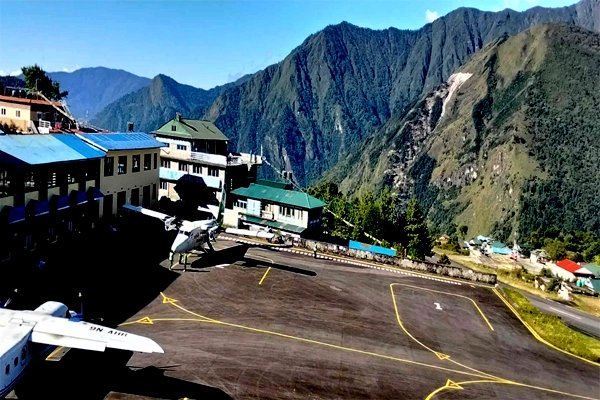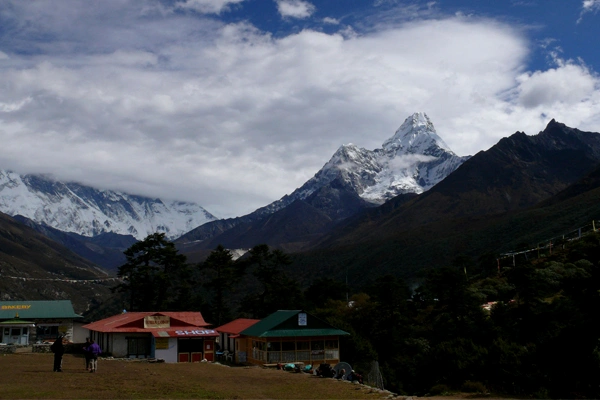Embarking on the Everest Base Camp trek is a thrilling and awe-inspiring adventure that beckons adventure enthusiasts and nature lovers from around the world. Situated in the heart of the Himalayas, the Everest Base Camp trek offers an unparalleled opportunity to witness breathtaking vistas, experience the Sherpa culture, and stand at the foot of the world's tallest peak, Mount Everest. In this article, we'll delve into essential fitness and training tips for the Everest Base Camp Trek that will prepare you for the journey of a lifetime.
The Everest Base Camp trek is a renowned trekking route that takes you through the stunning landscapes of the Khumbu region in Nepal. Starting from Lukla, the trail winds through lush forests, quaint Sherpa villages, and challenging terrains, ultimately leading to the base camp situated at an altitude of 5,364 meters (17,598 feet). This journey not only offers physical challenges but also an opportunity to immerse yourself in the rich local culture and breathtaking natural beauty.
Importance of Physical Fitness for the Trek
Undertaking the Everest Base Camp trek requires a significant level of physical fitness. The trek involves walking for several hours each day, often through steep ascents and descents. Cardiovascular endurance, muscular strength, and stamina are key to conquering challenging terrain. Prioritizing your fitness not only enhances your trekking experience but also ensures your safety at higher altitudes.
Understanding the Challenge
1. Altitude Sickness and Its Impact
Altitude sickness, also known as acute mountain sickness (AMS), is a common concern for trekkers in high-altitude regions. As you ascend to higher altitudes, the air becomes thinner, leading to a decrease in oxygen levels. This can result in symptoms like headaches, nausea, dizziness, and even more severe conditions like high altitude pulmonary edema (HAPE) or high altitude cerebral edema (HACE). Understanding these risks and learning how to prevent and manage altitude sickness is crucial for a safe trek.
2. Physical Demands of High-Altitude Trekking
Trekking in high-altitude regions like the Everest Base Camp requires a high level of physical fitness. The terrain is often rugged and steep, demanding strong cardiovascular endurance, muscular strength, and stamina. Training your body to handle long hours of walking and carrying a backpack is essential. Incorporating activities like hiking, stair climbing, and cardio workouts into your training routine can help you build the necessary physical strength.
3. Mental Preparation and Motivation
Embarking on a trek to Everest Base Camp is not just a physical challenge; it's a mental one as well. The journey can be both physically and emotionally demanding, testing your perseverance and mental fortitude. Developing a positive mindset, practicing mindfulness, and setting achievable goals can help you stay motivated during difficult stretches of the trek. Visualizing your success and focusing on the breathtaking views that await you can provide the mental boost you need to keep going.
Pre-Trek Fitness Preparation for the Everest Base Camp Trek
Embarking on the Everest Base Camp trek requires more than just a desire for adventure – it demands a well-prepared and conditioned body. By focusing on pre-trek fitness preparation, you can significantly enhance your chances of a successful and enjoyable journey.
1. Assessing Your Current Fitness Level
Before you begin any training regimen, it's essential to evaluate your current fitness level. This self-assessment will help you identify strengths and areas that need improvement. Consider factors like your cardiovascular endurance, muscular strength, flexibility, and overall health. Consulting a healthcare professional or a fitness trainer can provide valuable insights and guidance based on your assessment.
2. Developing a Personalized Training Plan
Once you have a clear understanding of your baseline fitness, it's time to create a personalized training plan. A well-structured plan will take into account your current fitness level, the duration of your trek, and your specific goals. Whether you're a seasoned athlete or new to fitness, a tailored plan ensures that you progress at a manageable pace and minimize the risk of injury.
3. Incorporating Cardiovascular Exercises
Cardiovascular endurance is crucial for trekking at high altitudes where oxygen is scarce. Engage in aerobic activities that elevate your heart rate and improve your lung capacity. Running, cycling, swimming, and brisk walking are excellent choices. Gradually increase the duration and intensity of your cardio workouts to simulate the demands of the trek. Remember to warm up and cool down to prevent strains and promote recovery.
4. Strengthening Leg Muscles and Core
Trekking in the Everest region involves navigating uneven terrain and ascending steep inclines. Strengthening your leg muscles and core is vital for stability and balance. Incorporate exercises like squats, lunges, step-ups, and leg presses to target your quadriceps, hamstrings, and glutes. Additionally, focus on core exercises such as planks, Russian twists, and leg raises to improve your overall body control.
5. Flexibility and Mobility Training
Flexibility plays a key role in preventing muscle strains and maintaining a comfortable stride while trekking. Integrate stretching and mobility exercises into your routine to improve joint range of motion. Yoga, Pilates, and dynamic stretching are effective ways to enhance flexibility and mobility.
6. Nutrition and Hydration
A well-balanced diet is essential to fuel your training and aid in muscle recovery. Focus on consuming a variety of nutrient-rich foods, including lean proteins, whole grains, fruits, and vegetables. Stay adequately hydrated by drinking water throughout the day, especially during and after workouts. Proper nutrition and hydration contribute to your overall fitness and energy levels.
7. Mental Conditioning
Preparing for the Everest Base Camp trek goes beyond physical training – mental conditioning is equally important. Develop strategies to stay motivated and focused during challenging moments. Practice visualization techniques, positive affirmations, and mindfulness to cultivate mental resilience. Building a strong mind-body connection can help you overcome obstacles and keep pushing forward.
Endurance Building for the Everest Base Camp Trek
As you gear up for the extraordinary journey to Everest Base Camp, one of the most crucial aspects of your preparation is building endurance. Endurance is your body's ability to sustain physical activity over extended periods, and it plays a pivotal role in your trekking success. In this section, we'll delve into the significance of aerobic fitness, the benefits of long-distance hiking, and the value of cross-training activities.
1. Importance of Aerobic Fitness
Aerobic fitness, often referred to as cardiovascular fitness, is the foundation of endurance. It involves the efficiency of your heart, lungs, and circulatory system in delivering oxygen to your muscles during sustained physical activity. The higher your aerobic capacity, the longer you can maintain your pace without tiring quickly. Engaging in aerobic exercises like running, cycling, and swimming boosts your cardiovascular endurance and prepares your body for the altitude challenges of the Everest Base Camp trek.
2. Long-Distance Hiking for Endurance
While various exercises contribute to your overall endurance, there's no substitute for the specific demands of long-distance hiking. Incorporating practice hikes into your training plan is essential to simulate the conditions you'll encounter on the trek. Start with shorter hikes and gradually increase the distance and elevation gain. This not only enhances your physical stamina but also familiarizes you with the sensation of trekking for extended periods.
3. Cross-Training Activities
Cross-training involves engaging in a variety of exercises to target different muscle groups and improve overall fitness. It prevents overuse injuries and keeps your training routine engaging. Activities like swimming, cycling, and yoga can complement your endurance-building efforts by working on different aspects of your fitness. Cross-training also allows your body to recover from the repetitive stress of trek-specific training.
4. Nutrition and Hydration
Endurance training places increased demands on your body's energy stores. Fueling yourself with proper nutrition and staying hydrated is essential for maintaining performance and recovery. Consume a balanced diet rich in carbohydrates, proteins, and healthy fats to provide the energy required for long-duration activities. Hydrate adequately before, during, and after your workouts to prevent dehydration and fatigue.
5. Mental Resilience
Building endurance isn't just about physical conditioning; it's also about mental resilience. As you push your limits during long training sessions, you'll face moments of discomfort and fatigue. Developing mental toughness, positive self-talk, and coping strategies can help you overcome these challenges. Practicing mindfulness and visualization techniques can keep you focused and motivated during the toughest stretches of your training.
6. Rest and Recovery
While building endurance is essential, giving your body time to rest and recover is equally crucial. Overtraining can lead to burnout and injuries. Incorporate rest days into your training plan and prioritize quality sleep. Rest allows your muscles to repair and adapt, ensuring you're at your best when tackling demanding training sessions.
7. Tracking Progress
Keep a record of your training sessions, noting the distance, duration, and elevation gained. Tracking your progress helps you monitor your improvement over time and make necessary adjustments to your training plan.
Strength Training for the Everest Base Camp Trek
As you prepare to conquer the heights of Everest Base Camp, integrating strength training into your regimen can make a significant difference in your trekking experience. Strength training enhances your muscular endurance, stability, and overall physical capabilities, ensuring that you're well-equipped to tackle the challenging terrains ahead. In this section, we'll explore the importance of targeting specific muscle groups, the effectiveness of bodyweight exercises, and the benefits of weightlifting and resistance training.
1. Targeting Muscle Groups Essential for Trekking
Trekking in the Everest region demands more than just cardiovascular fitness – it requires a balance of strength and endurance to navigate uneven trails and steep ascents. Prioritizing muscle groups such as your quadriceps, hamstrings, calves, glutes, and core is crucial. These muscles play a pivotal role in maintaining stability, balance, and power during your trek. Tailoring your strength training routine to focus on these muscle groups ensures that your body is prepared for the physical demands of the journey.
2. Bodyweight Exercises for Functional Strength
Bodyweight exercises are a practical and effective way to build functional strength. They mimic the movements you'll encounter while trekking and engage multiple muscle groups simultaneously. Incorporate exercises like squats, lunges, step-ups, and push-ups to enhance your lower body strength and upper body stability. Bodyweight exercises also improve your proprioception and coordination, essential for navigating challenging terrains.
3. Weightlifting and Resistance Training
Introducing weights and resistance bands to your training routine adds an extra dimension to your strength training efforts. Weightlifting helps you progressively increase the load on your muscles, stimulating muscle growth and overall strength. Compound movements like deadlifts, squats, and overhead presses target multiple muscle groups, making them particularly effective. Resistance bands provide variable resistance, allowing you to engage muscles in different ways and strengthen them from various angles.
4. Proper Form and Technique
When engaging in strength training, prioritize proper form and technique over heavy weights. Correct form reduces the risk of injury and ensures that you're targeting the intended muscle groups effectively. If you're new to strength training, consider seeking guidance from a fitness professional to learn proper lifting techniques and avoid common mistakes.
5. Recovery and Flexibility
Incorporate flexibility and mobility exercises into your routine to maintain muscle elasticity and prevent stiffness. Stretching post-workout and on rest days promotes recovery and reduces the risk of injury. Activities like yoga and foam rolling can improve your flexibility and aid in muscle relaxation.
6. Periodization
Consider implementing a periodization plan in your strength training. Periodization involves dividing your training into specific phases with varying intensities and focuses. This approach prevents plateaus, promotes continuous improvement, and minimizes the risk of overtraining.
Altitude Acclimatization Strategies
One of the most critical aspects of preparing for the Everest Base Camp trek is understanding and implementing effective altitude acclimatization strategies. As you ascend to higher elevations, your body needs time to adapt to the lower oxygen levels. Failing to acclimatize properly can lead to altitude sickness and compromise your trekking experience. In this section, we'll explore the acclimatization process, recommended altitude gain guidelines, and the importance of rest and adaptation days during the trek.
1. Understanding the Acclimatization Process
Altitude acclimatization is the gradual adjustment of your body to reduced oxygen levels at higher elevations. It involves physiological changes that allow your body to deliver oxygen to your muscles and vital organs more efficiently. Proper acclimatization minimizes the risk of altitude-related illnesses and ensures a safer and more enjoyable trek. The process generally takes a few days, during which your body adapts to the changing environment.
2. Recommended Altitude Gain Guidelines
The key to successful altitude acclimatization is to ascend gradually. Avoid rapid altitude gain, as it increases the risk of altitude sickness. The general guideline is to gain no more than 300 to 500 meters (about 1,000 to 1,600 feet) in elevation per day once you reach altitudes above 3,000 meters (9,800 feet). This allows your body to adjust to changing conditions without overwhelming your system.
3. Rest and Adaptation Days During the Trek
Rest and adaptation days are crucial components of your trekking itinerary. As you ascend, your body needs time to catch up with the changing altitude. Design your trek schedule to include rest days at higher elevations, allowing your body to adjust before moving to even higher altitudes. These days are also an opportunity to explore the local culture, and scenery, and acclimate further.
4. Hydration and Nutrition
Staying hydrated and properly nourished are essential factors in aiding the acclimatization process. Drink plenty of fluids throughout the day, even if you don't feel thirsty. Proper hydration supports your body's ability to transport oxygen and nutrients. Consume a balanced diet rich in carbohydrates, proteins, and vitamins to maintain your energy levels and facilitate recovery.
5. Recognizing Altitude Sickness Symptoms
Altitude sickness can affect anyone, regardless of fitness level or previous altitude experience. Understanding the symptoms is vital for early detection and intervention. Common signs of altitude sickness include headaches, nausea, dizziness, fatigue, and shortness of breath. If you experience severe symptoms like confusion, difficulty walking, or persistent vomiting, descend to a lower altitude immediately and seek medical attention.
6. Medication and Oxygen
In some cases, trekking at high altitudes may require the use of medication or supplemental oxygen. Consult a healthcare professional before your trek to discuss potential options. Diamox, a medication that helps with acclimatization, may be recommended. Carry a portable oxygen supply in case of emergencies, but always prioritize gradual ascent and proper acclimatization practices.
Practical Hiking Tips before embarking on the actual EBC Trek
As you embark on the exhilarating journey to Everest Base Camp, mastering practical hiking techniques becomes essential for a successful and enjoyable trekking experience. From pacing yourself on long trekking days to utilizing effective breathing techniques at high altitudes, and employing smart strategies for uphill and downhill sections, these practical tips will help you navigate the challenging terrain with confidence.
1. Pacing Yourself for Long Trekking Days
Trekking to Everest Base Camp involves long days on the trail, and pacing yourself is key to conserving energy and preventing fatigue. Start each day at a comfortable pace that allows you to maintain a steady rhythm. Break down the trail into manageable segments, and take short breaks at regular intervals to rest, hydrate, and refuel. Remember, it's not a race – maintaining a consistent pace ensures you have the endurance to reach your destination without burning out.
2. Breathing Techniques for High Altitudes
Breathing becomes more challenging at higher altitudes due to the lower oxygen levels. Practice controlled and deep breathing to optimize oxygen intake. Inhale deeply through your nose, expand your lungs fully, and exhale slowly through your mouth. This technique helps oxygenate your blood and minimizes the risk of altitude-related discomfort. Focusing on your breath also aids in maintaining a calm and focused mindset.
3. Uphill and Downhill Trekking Strategies
Tackling uphill and downhill sections requires different techniques. For uphill sections, take shorter, deliberate steps, maintaining a consistent pace. Use your arms for balance and propulsion, and engage your core to support your posture. On downhill stretches, lean slightly forward, keep your knees slightly bent, and take longer strides. Use your quadriceps to control your descent and reduce the impact on your knees.
4. Trekking Pole Benefits
Trekking poles are invaluable tools for stability, balance, and reducing strain on your joints, especially during challenging terrain. When ascending, plant the poles slightly ahead of you and push down to help propel yourself forward. During descents, plant the poles behind you to provide stability and reduce pressure on your knees. Trekking poles also help distribute your effort more evenly, conserving energy over long distances.
5. Footwear and Foot Care
Investing in proper trekking footwear is essential for a comfortable and injury-free journey. Choose sturdy hiking boots with ankle support and a grippy sole for traction on varied terrains. Break in your boots before the trek to avoid blisters and discomfort. Pay attention to foot care – keep your feet dry, change socks when needed, and treat any hotspots or blisters promptly to prevent further issues.
Conclusion
As we conclude our comprehensive guide to fitness and training tips for the Everest Base Camp trek, let's recap the essential fitness and training tips that will undoubtedly contribute to your successful and transformative journey. From altitude acclimatization to strength training, practical hiking techniques, and mental resilience, these key takeaways will serve as your compass for a safe, enjoyable, and unforgettable trekking experience.




